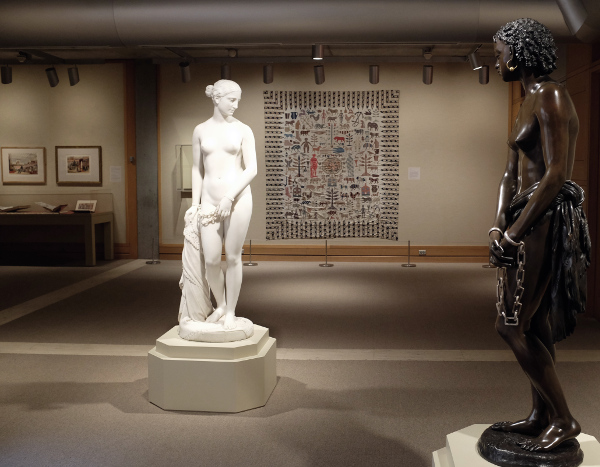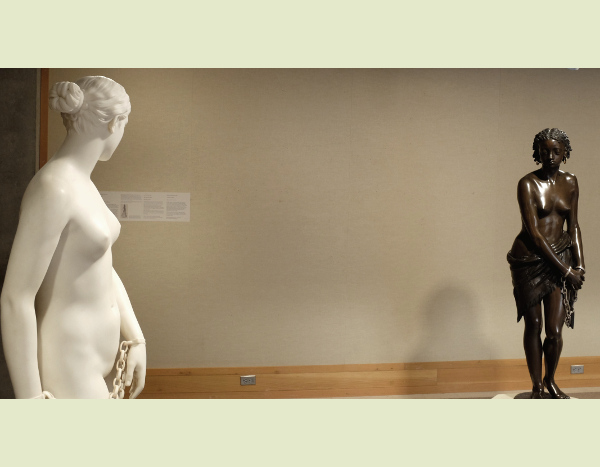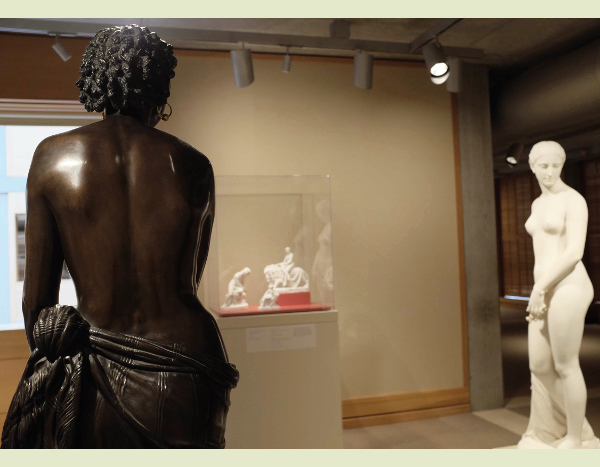The browser will either open the file, download it, or display a dialog.
A Transatlantic Object
The aim of this special issue on The Greek Slave is to offer a sustained examination of one of the most famous works of the nineteenth century, bringing together interdisciplinary and transatlantic perspectives on its political, cultural, aesthetic, and material significance (fig. 1). The Greek Slave is an icon of American art, and perhaps it is little wonder that its extensive historiography has been almost exclusively focused on its role in American culture, particularly in relation to the history of slavery and abolition. However, the circumstances of The Greek Slave’s production, dissemination, and reception initially unfolded in Italy and Britain, complicating its designation as a work of “American art.” Multiple Greek Slaves were commissioned in Florence by both English and American patrons; executed with the aid of skilled Italian craftsmen; shipped to London, Paris, New York, and other cities; exhibited at galleries and world’s fairs in Europe and America; and copied by British, American, and French firms in the form of prints, photographs, and statuettes. Today, various versions of the statue remain in American and British collections. Together, these contexts make The Greek Slave not only one of the most international and reproduced objects of the nineteenth century, but also one of the most persistently visible and debated sculptures of all time.
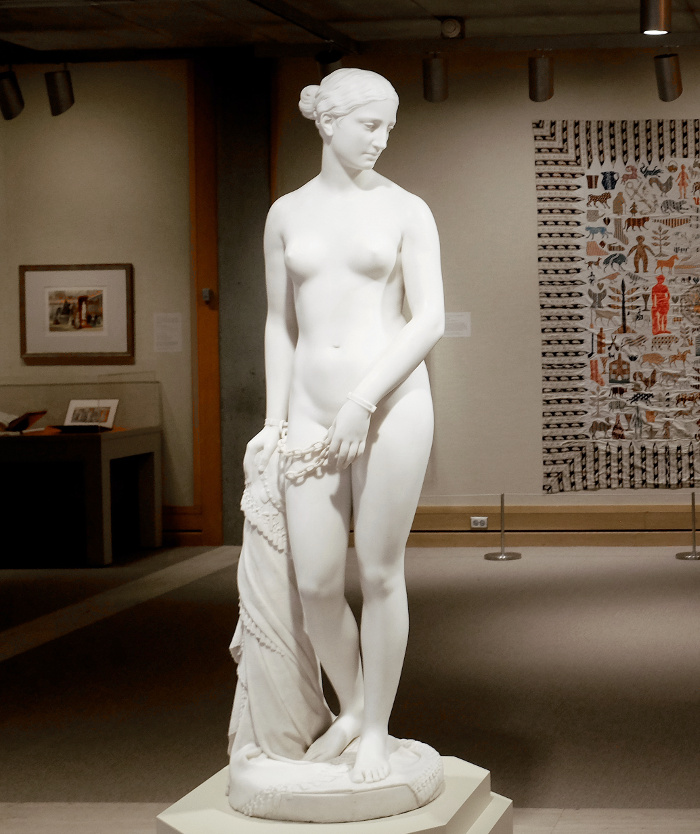
Fig. 1, View of Sculpture Victorious: Art in an Age of Invention, 1837–1901, Yale Center for British Art, New Haven, 2014, showing Hiram Powers, The Greek Slave, 1847. Marble. Newark Museum, Newark. Courtesy of the Newark Museum. Photograph by Nick Mead, 2014.
The underpinning principles that have guided our approach to this special issue are the twin themes of the “transatlantic” and the “object.” This approach has wider implications both for the field of American art and for sculpture studies. First, it recasts American art in an international context; indeed, it goes even further and recasts American art as international art, challenging the orthodoxies of a “national school” approach. Together, the essays suggest that American art is not constrained by the geographical or conceptual boundaries of the nation, and that the very meaning of “American”—in racial, political, and geographical terms—changes with different iterations of the artwork. Second, it brings into focus the importance of The Greek Slave as sculpture. In the history of sculpture, The Greek Slave can stand as an exemplar of the issues that have dogged the field. In particular, we challenge orthodox conceptions of “original” and “copy.” Nineteenth-century sculpture is still too often considered with terms of reference that were conceived for painting. Notions of authorship and of a linear sequence from design to an original, finished work are deeply ingrained, but they apply differently in the case of sculpture. Sculpture was a reproductive art, more akin to photography than to painting. The finished marble statues were reproduced from the plaster reproduction of the sculptor’s clay model. Each of the six marble versions of The Greek Slave was an original, based on the clay model destroyed in the process of making the plaster.
The marbles themselves were then reproduced in a range of two- and three-dimensional media. The Greek Slave therefore comprises a sequence of objects, made with different materials and technologies, produced for a variety of audiences, and purchased for different reasons. Each has its own history, and each was displayed and viewed distinctively: from the canopied, rotating marble at the Great Exhibition of the Works of Industry of All Nations (London, 1851) to the intimate handling of the fugitive daguerreotype; and from its presence amidst the slave markets of New Orleans to the mantel of the abolitionist’s parlor. Just as it took on multiple iterations and forms, The Greek Slave took on multiple meanings in different contexts. Here, our “multi-object” approach provides a corrective not only for histories of The Greek Slave, but also for those of other nineteenth-century sculptures, demonstrating that even “reproductions” or “copies” linked by a unifying iconographic motif also existed as materially resonant objects in their own right.
New Contexts for The Greek Slave
This project has its origin in a major exhibition, Sculpture Victorious: Art in an Age of Invention, 1837–1901, which we curated with our colleague Jason Edwards, and which was accompanied by a substantial publication.[1] Sculpture Victorious was the first synoptic exhibition about sculpture in Victorian Britain and its empire. It opened at the Yale Center for British Art in New Haven in the autumn of 2014 and traveled to Tate Britain in London in the spring of 2015, where the installation was curated by Greg Sullivan and Caroline Corbeau-Parsons. At the very outset we decided that The Greek Slave would play a central role in demonstrating the international history of British sculpture. In making this claim, we sought to broaden the interpretation of the statue’s own history, moving it out of an insistently American frame, and rethinking it as a transatlantic object. Sculpture Victorious also challenged definitions of how sculptural objects are categorized, refusing conventional distinctions between fine art and decorative art, or between original and copy. Here too The Greek Slave played an exemplary role, both in the different versions of the full-size marble and in the wide range of two- and three-dimensional reproductions.
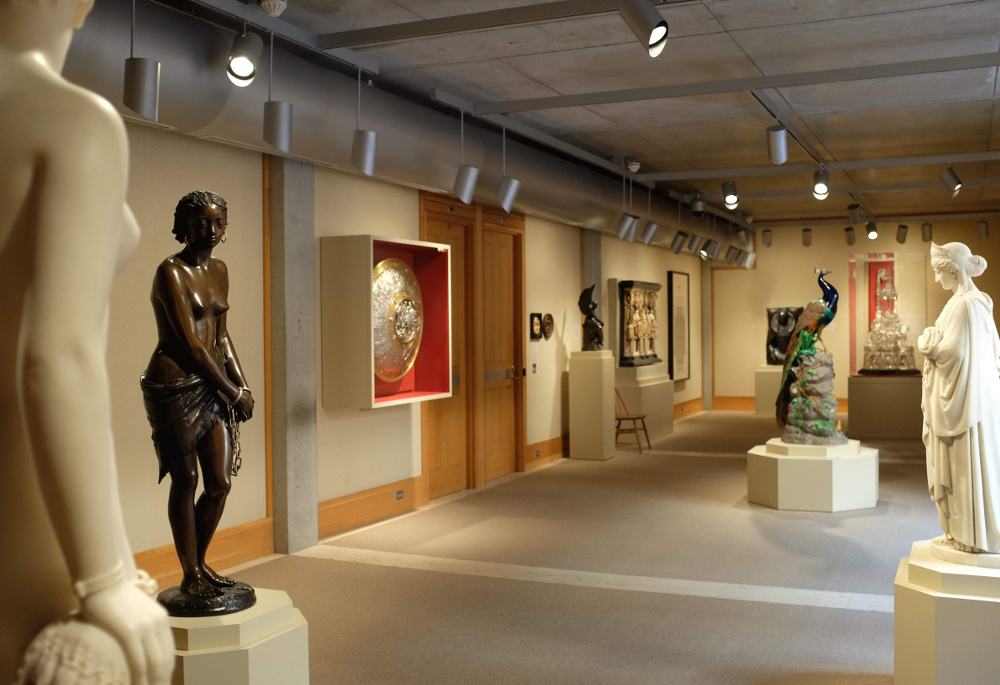
Fig. 2, View of Sculpture Victorious: Art in an Age of Invention, 1837–1901, Yale Center for British Art, New Haven, 2014. Left to right: Hiram Powers, The Greek Slave, 1847. Marble. Newark Museum, Newark. Courtesy of the Newark Museum; John Bell, The American Slave [A Daughter of Eve], ca. 1862. Bronze patinated electrotype with silver and gold plating. The Armstrong Collection, National Trust, Cragside, Rothbury, Northumberland. Courtesy of the National Trust; Harriet Goodhue Hosmer, Zenobia in Chains, after 1859, possibly 1874. Marble. Wadsworth Atheneum Museum of Art, Hartford. Photograph by Nick Mead, 2014.
In Sculpture Victorious, we positioned The Greek Slave (1847, third version, Newark Museum, Newark, NJ) in close proximity to two statues that drew upon a related trope: The American Slave by the British sculptor John Bell (ca. 1862, loaned from Cragside, National Trust, in the United Kingdom), and Zenobia in Chains, by the American sculptor Harriet Goodhue Hosmer (after 1859, possibly 1874, loaned from the Wadsworth Athenaeum, Hartford, in the United States; fig. 2). Like The Greek Slave, these statues had made their name in London, when versions of both were shown at the 1862 International Exhibition. Within Sculpture Victorious this remarkable trio of statues—each, in its own distinct way, representing a chained female figure—became a touchstone for the exhibition as a whole, which, through comparison and contrast, opened new ways of thinking about all three works.
The conjunction of The Greek Slave with The American Slave was particularly powerful (figs. 3a–3c). Mimicking the pose of Powers’s statue, but executed as an electrotype, the African woman depicted by Bell is shown standing on the shores of the Atlantic, awaiting transportation to America as a slave. The statue was made as a direct riposte to Powers’s white marble figure. Although the tacit relationship between the two works has been noted in a handful of scholarly accounts, Bell’s statue has long stood as The Greek Slave’s shadow—invoked only to make a comparison, rather than being considered on its own terms. Prior to our exhibition, the two works had never been brought physically together; indeed, The American Slave had never before been lent to a museum either in Britain or the United States. Seeing this obscure work side by side with the famous Greek Slave made for an almost shocking visual experience. For audiences familiar with Powers’s statue, the juxtaposition opened up surprising new ways of reconsidering his visual language and brought to the fore the transatlantic world in which both objects were made, shown, and understood. It was revealing to see how closely the two figures echo each other through opposite values and qualities. Their different articulations of race, physiognomy, expression, and sentiment are conveyed in and through their materials (figs. 4, 5): marble and bronze take on meaning as white and black skin, while the chain—one in marble, the other in silver—appears decorative in the former, and real in the latter (figs. 6, 7). Placing the statues side by side also made clear that the debate about and interpretation of The Greek Slave in the nineteenth century was not only conducted in texts but also through sculpture itself.
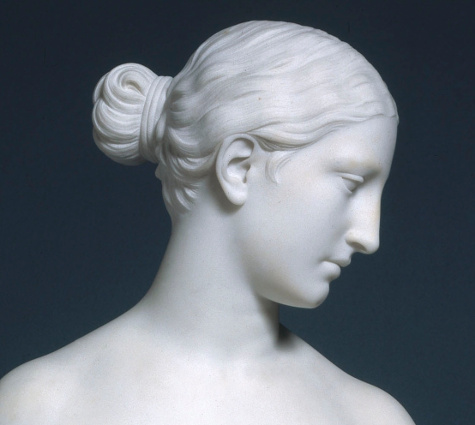
Fig. 4, Detail of head, Hiram Powers, The Greek Slave, 1866. Marble. Brooklyn Museum, Brooklyn.
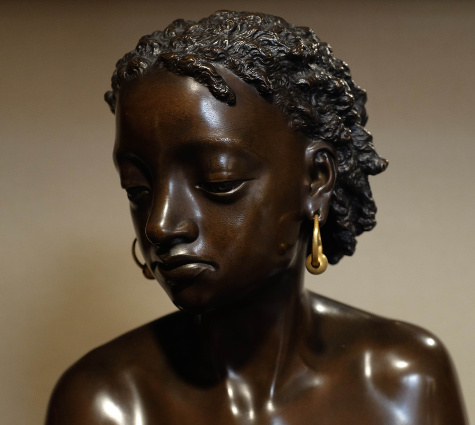
Fig. 5, Detail of head, John Bell, The American Slave [A Daughter of Eve], ca. 1862. Bronze patinated electrotype with silver and gold plating. The Armstrong Collection, National Trust, Cragside, Rothbury, Northumberland. Courtesy of the National Trust. Photograph by Nick Mead, 2014.
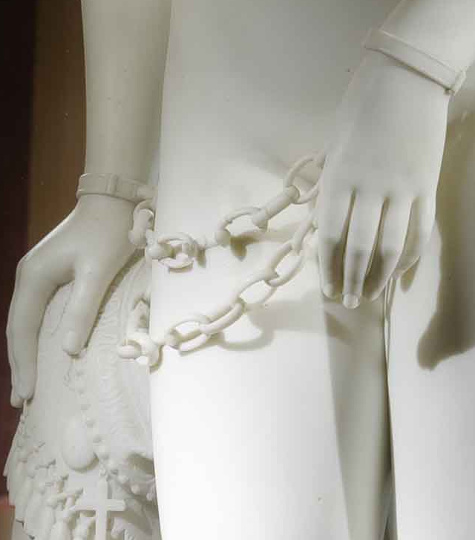
Fig. 6, Detail of chains, Hiram Powers, The Greek Slave, 1844. Marble. Raby Castle, Staindrop, Darlington, County Durham. Reproduced with the kind permission of the Rt. Hon. Lord Barnard, Raby Castle.
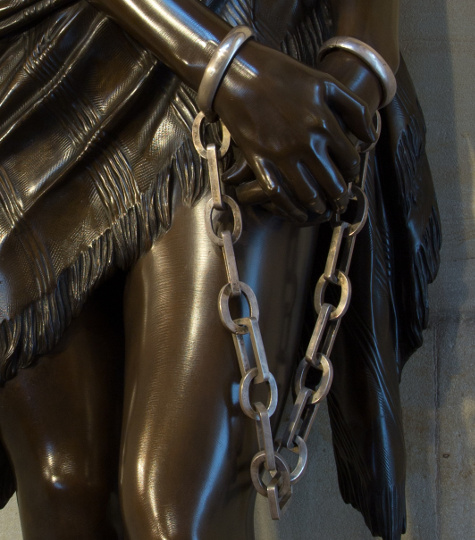
Fig. 7, Detail of chains, John Bell, The American Slave [A Daughter of Eve], ca. 1862. Bronze patinated electrotype with silver and gold plating. The Armstrong Collection, National Trust, Cragside, Rothbury, Northumberland. Courtesy of the National Trust. Photograph by Nick Mead, 2014.
The statue was included in a section of the exhibition about international exhibitions, and the ways in which new audiences—comprising millions of people of diverse social backgrounds, not only from Britain but from around the globe—encountered sculpture. Here, we made a case for the centrality of sculptures like Powers’s to Victorian culture, using the setting of international exhibitions as a context that demonstrated the overweighing importance of national achievement for both exhibitors and audiences. We also wanted to show how attention to sculpture began with the display of works, but extended well beyond the physical and chronological boundaries of an exhibition. Alongside the full-size marble, we presented a detailed case study about its presentation at the Great Exhibition and its subsequent circulation in numerous sites and forms, and for different audiences (fig. 8). Alongside prints, photographs, and stereoscopes that captured The Greek Slave’s display—on a rotating pedestal in a red-curtained gazebo, with the American eagle hovering above to mark the American section—we included objects charting its reproduction in ceramic for the middle-class parlor; its popularity in photographic media and in print publications, both cheap and expensive; and its representation in more unexpected forms, such as music and a quilt.
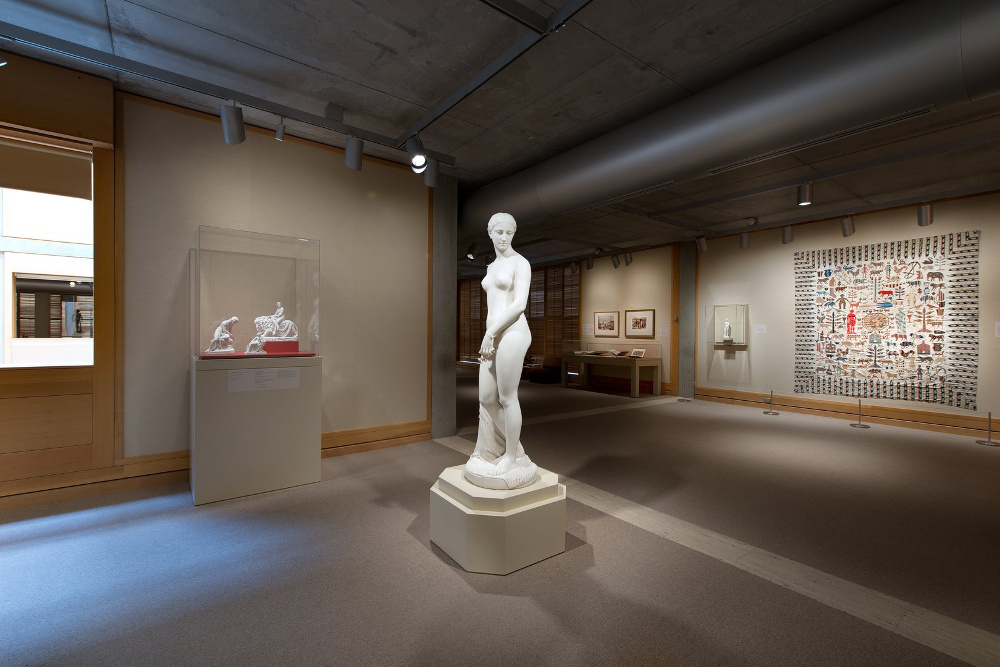
Fig. 8, View of Sculpture Victorious: Art in an Age of Invention, 1837–1901, Yale Center for British Art, New Haven, 2014, showing Hiram Powers, The Greek Slave, 1847. Marble. Newark Museum, Newark. Courtesy of the Newark Museum. Photograph by Richard Caspole, 2014.
During the run of Sculpture Victorious, we organized a two-day international colloquium focusing on The Greek Slave, generously sponsored by the Terra Foundation for American Art, which had also provided the funding for the loan of the third marble version of The Greek Slave from the Newark Museum. In addition to hearing and discussing papers, participants at the colloquium were able to view the exhibition and consider the presentation of the statue in the context of the Great Exhibition’s venue, the Crystal Palace. The loan from Newark allowed us to make a comparison with the fifth version (1850) standing in the American art galleries across the street at the Yale University Art Gallery: an arrangement that brought out the question of the transatlantic, with Chapel Street in New Haven serving as the ocean. The colloquium served as the springboard for this publication. As well as allowing the participants to develop the ideas they had presented, this issue of Nineteenth-Century Art Worldwide has enabled us to invite other scholars to consider The Greek Slave in new ways, in order to extend our collective analysis of the object, historically and methodologically. In presenting that multifaceted analysis here, we hope to suggest ways in which other cultural products might be similarly reconceived.
Multi-Object Histories
By locating the statue and the sculptor in a cosmopolitan, transatlantic context, we trace the history of The Greek Slave more fully: not as a single object for which any reproduction acts as a surrogate, but as a series of distinctive objects, which include the full-size marble statues as well as the many varied reproductions that take the form and name of The Greek Slave. This multi-object history opens up a richer and more nuanced understanding of the statue’s resonance in political debate across the United States, North and South, and the United Kingdom. We have been enabled in this approach by our interdisciplinary group of contributors, which includes scholars with backgrounds in not only history and art history, but also conservation, art practice, history of photography, Victorian studies, and performance studies.
While The Greek Slave’s status as an icon of the conflict over slavery in American history has ensured sustained scholarly interest in the work, it has also put Hiram Powers’s statues into a more or less illustrative role. The Greek Slave tends to be regarded as a kind of catalyst that sparked an enormous response to the pressing political issues of the antebellum and Civil War periods. But like a catalyst, the statue has become less important for itself than for what it activated. Thus, the multi-object materiality of The Greek Slave is reduced to a singular image that not only denies the quiddity of the statues but also reduces their potential meanings to a mere reflection of the state of affairs that surrounded them. In this special issue we want to return attention to the materiality of The Greek Slave. Our designation of the statues as transatlantic objects is a reminder of their conception as physical sculpture that was moved across vast distances. At the same time, the word “object” is also a shorthand, because The Greek Slave encompasses many objects, each with its own history, resonance, and accrued meanings.
Multiplicity is built into the statues themselves: between 1843 and 1866, Hiram Powers produced six full-size marble versions. Five of these were copied from a full-size plaster cast, which derived from Powers’s initial clay model, while the sixth and final version was copied from a second full-size plaster, which is thought to have been cast from the same molds as the first. As the digital interactive “Mapping The Greek Slave” in this special issue demonstrates, the existence of these multiple marble versions ensured that The Greek Slave was on uninterrupted display at various locations on both sides of the Atlantic from the date of their making onward. Powers also produced smaller-scale versions of the statue, as well as extracting a bust form, which was repeated multiple times.
When we take account of the multiplicity of The Greek Slave as a set of related but individual statues, it also becomes clear that each of these objects played an instrumental role in disseminating fame and celebrity for itself, for the others, and for the sculptor himself. As the essays demonstrate, for Powers, exhibiting his statues was as important as selling them, and indeed he was willing to defer sales if it meant a work could be displayed. The important point here is that there is nothing accidental about The Greek Slave’s fame: it was achieved systematically and strategically through the artist’s careful planning.
There has been some uncertainty in the scholarship as to how the relationship between the statues should be quantified, and a common misconception is that the first version of The Greek Slave (now at Raby Castle, Staindrop) represents an original work, while the remaining statues are copies. This is reflected both in the way that scholars tend to conflate the statues into one object, and in museum labels that denote the later versions as being “after an original of 1844.” This labeling is entirely consistent with the larger preoccupations of art history, a field that is essentially motivated by the idea that originality is the attainment of art. This framework of value extends not only to the unique object, but also to singularity in artistic expression and style. Thus, The Greek Slave is in a double bind, in that it appears unoriginal both in its homage to the classical ideal and by its own insistent multiplicity.
If we allow the first statue to count as an original, we must allow all six to do so, because they were not derived from each other but from a plaster model. This may seem like a small detail, but in fact it touches on a fundamental misunderstanding of sculptural practice, with significant ramifications. The Greek Slave is an exemplar of the ideal marble sculpture that was produced in great quantities throughout the nineteenth century (and indeed earlier); misconceptions relating to it are therefore multiplied across a massive body of works. Given the importance of concepts of originality in modern art-historical thinking, it is perhaps no wonder that nineteenth-century marble sculpture is so little regarded in scholarship today.
In sum, the relationship between “original” and “copy,” as it has been applied to The Greek Slave, does not reflect the nature of sculptural production. Neither does it reflect the historical conception of these terms. In archival material relating to Powers and in published articles, the terms “original,” “copy,” “duplicate,” and “repetition” were very much part of the vocabulary around The Greek Slave, indicating that there was a concern to determine their meaning and the relationship between them, but in the sense of explaining the production process.[2] The word “original” was applied primarily to the plaster model, which was also understood as a precise replica of the clay figure from which it was made. The plaster was a highly valued object because it was the primary record of the artist’s own work—all of its detail and nuances would be transferred into marble. As Powers’s patron George Henry Calvert explained in 1847, the plaster is “an exact fac-simile of the original clay figure, in hard, smooth plaster of Paris, capable of bearing the usage of the studio, and receiving the many marks that are to guide the marble-cutters.” The marble, in turn, was carved from the plaster with “unsurpassing accuracy” in order to “characterize the original as moulded in clay by the hand of Powers.”[3] The sequential relationship from clay to plaster to marble statue is indexed not only by the careful replication of form, but by traces of studio practice, such as the mark on the head made by the hook that attached the marble block to the pointing machine, which is mirrored by an analogous mark in the plaster. The hole that was left has been filled but can be seen on several of the statues (figs. 9, 10).
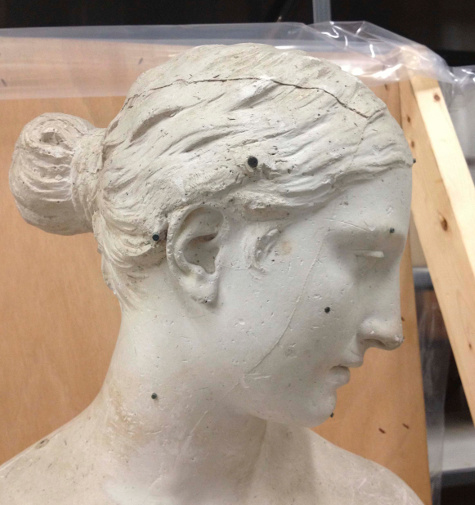
Fig. 9, Detail of head, Hiram Powers, second pointing model of The Greek Slave, after 1843, likely 1865. Plaster with metal pins and metal shackles. Smithsonian American Art Museum, Washington, DC. Photograph by Martina Droth, 2013.
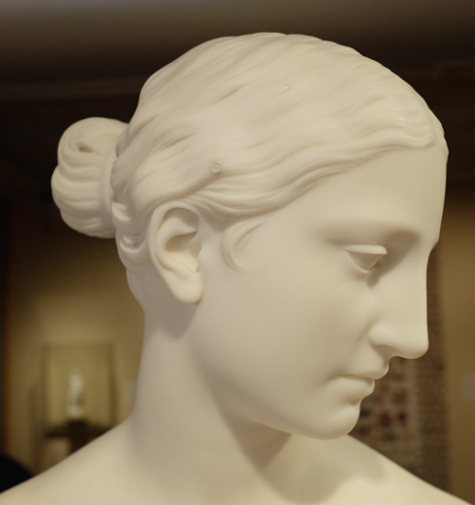
Fig. 10, Detail of head, Hiram Powers, The Greek Slave, 1847. Marble. Newark Museum, Newark. Courtesy of the Newark Museum. Photograph by Nick Mead, 2014.
The first version of The Greek Slave was often referred to as the first “copy” or “duplicate,” from the “original plaster.” Further “copies” or “duplicates” were subsequently executed.[4] But while they are copies from the model, their transference into a new material also makes them original works in their own right. This was critical to Powers, who was invested in the particular way in which the marble was to be worked and finished. To quote from an 1848 pamphlet: “These repetitions, it is hardly necessary to state, are all executed from the first model, and as far as the art of sculpture is concerned, all are equally entitled to be considered originals.”[5] Perhaps describing the marble as an “original copy” would better allude to the way in which Powers and his patrons tended to think of their statues.
The word “copy” incorporated inexactitude. Powers introduced modifications into several of the statues, such as in the drapery, and for him and his patrons this made a statue singular and unique, even in the context of similar versions. There was a financial imperative built into these distinctions. Powers recognized that patrons felt their statues could be devalued by the existence of the others. In 1870, when his fifth version of The Greek Slave (formerly owned by Anatole Demidoff, Prince of San Donato) was sold at auction in Paris, Powers claimed that such a high price was paid for the statue (53,000 French francs, or 2,120 British pounds) because he had made it known that his sixth version would be his last. He wrote to the new owner of the sixth statue, Edwin W. Stoughton: “I dare say that this large sum was bid for it on account of my letter to you in which I promised never to execute another without your consent.”[6]
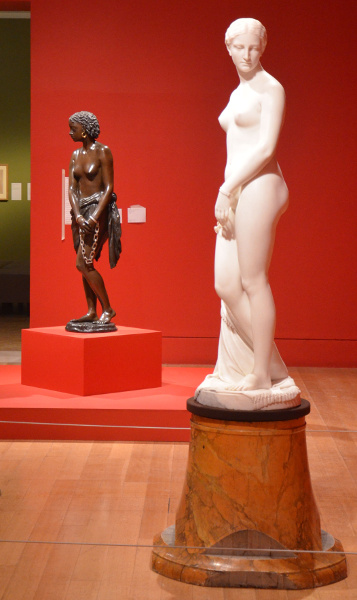
Fig. 11, View of Sculpture Victorious: Art in an Age of Invention, 1837–1901, Tate Britain, London, 2015. Left to right: John Bell, The American Slave [A Daughter of Eve], ca. 1862. Bronze patinated electrotype with silver and gold plating. The Armstrong Collection, National Trust, Cragside, Rothbury, Northumberland. Courtesy of the National Trust; Hiram Powers, The Greek Slave, 1847. Marble, Newark Museum, Newark. Courtesy of the Newark Museum. Photograph by Greg Sullivan, 2015.
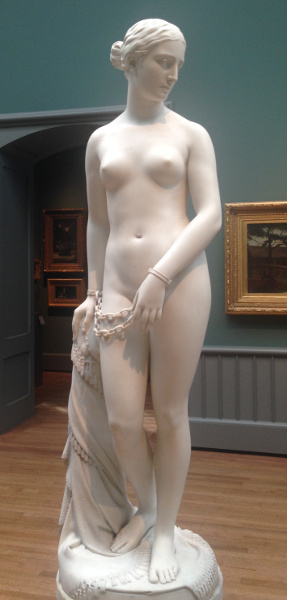
Fig. 12, View of Hiram Powers, The Greek Slave (1850, marble) at the Yale University Art Gallery, New Haven. Photograph by Nick Mead, 2014.
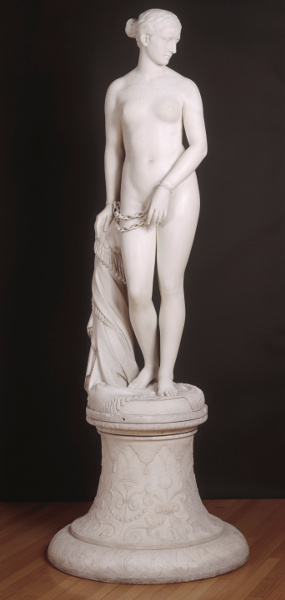
Fig. 13, Hiram Powers, The Greek Slave, 1850. Marble. Yale University Art Gallery, New Haven.
The exhibition Sculpture Victorious brought three of Powers’s original statues into play: the first version, on loan from Raby Castle, was on view at Tate Britain, standing on its original (formerly rotating) pedestal (fig. 11); the third version, on loan from the Newark Museum, at the Yale Center for British Art; and the fifth version, which belongs to the Yale University Art Gallery, as part of the permanent displays of the American collections (fig. 12). For audiences at Yale, this was a unique opportunity to consider the two statues’ similarities and differences as objects, and the modes of their display. At the Art Gallery, the statue stood on the elaborate pedestal Powers made for it (fig. 13); at the Center, on a simple, low plinth that brought the statue closer to the viewer. The contrast between the two displays—at the Art Gallery amidst contemporaneous works of American art; at the Center within an exhibition concerned with Victorian Britain—made very apparent the ways in which curatorially constructed contexts inflect interpretation. The close proximity of the two Greek Slaves also brought to the fore the multiplicity of sculpture, prompting consideration of how we understand originality and replication.
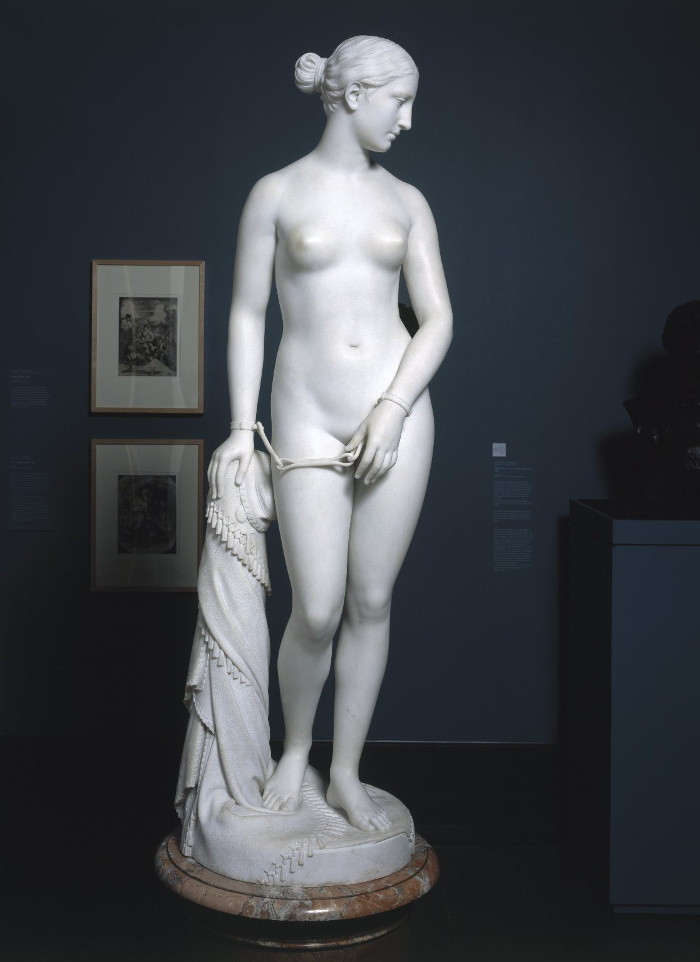
Fig. 14, Hiram Powers, The Greek Slave, 1866. Marble. Brooklyn Museum, Brooklyn.
In considering these issues during the colloquium, it became evident how well The Greek Slave exemplifies the blind spot to the material object that persists in the scholarship on nineteenth-century sculpture. Almost without exception, the six versions of the statue have been considered as interchangeable, any one version—or indeed, any reproduction—standing as well for The Greek Slave as any other. The result is to turn The Greek Slave into a concept, essentially detached from any particular object. This not only ignores the extraordinary resonance of the statues as individual works of sculpture; it also misses the nuanced relationships each developed in its specific geographical and chronological trajectories. The blind spot is so strong that even the sixth and final version (now in the Brooklyn Museum, fig. 14) has barely registered as distinct—despite the fact that it was produced at the end of the Civil War, and despite the blatant revision that Powers made to address the precise historical moment: the substitution of the linked chain with a set of straight-bar manacles, copied from the iron object on the plaster model (fig. 15).
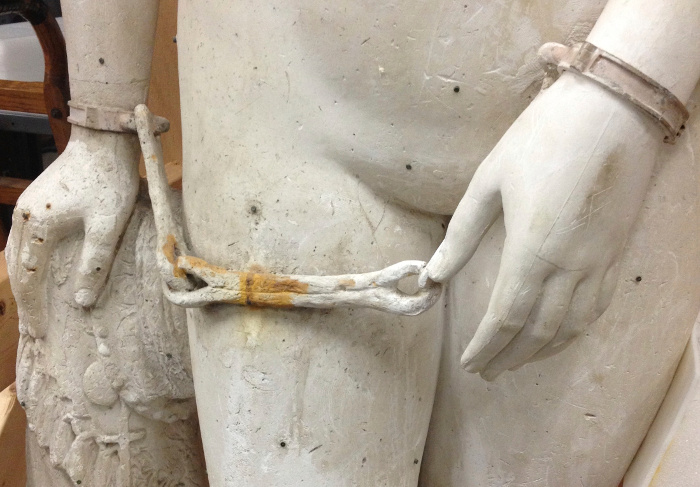
Fig. 15, Detail of shackles, Hiram Powers, second pointing model of The Greek Slave, after 1843, likely 1865. Plaster with metal pins and metal shackles. Smithsonian American Art Museum, Washington, DC. Photograph by Martina Droth, 2013.
There has been disagreement in the scholarship about the date of the statue, which is sometimes given as 1866 (as it is by Richard P. Wunder, the author of Powers’s catalogue raisonné) and more often as 1869, the year of its acquisition by Edwin W. Stoughton.[7] However, as Martina Droth writes in “Mapping The Greek Slave,” archival records support the earlier date. With the plaster conceived in 1865, and the marble completed in 1866, the sixth version stands like an exclamation mark at the end of a long sentence that begins in 1843 and unfolds through the antebellum decades to the end of the Civil War. The astonishing elision among scholars of this final, vocal statement has meant that interpretation of the statues’ changing relationships to the political issues as they developed across these crucial years has not been fully exploited. It is worth pausing on this point: given that the enormous historiography has almost exclusively focused on precisely this context, it is truly remarkable that the signposts contained in the statues themselves have not been fully recognized.
The ubiquitous visibility of the six marble statues gave rise to The Greek Slave’s subsequent multiplication into myriad other forms, taking the shape, title, and concept for new kinds of objects: statuettes, ceramics, photographs, stereographs, prints, satires, textiles, tableaux vivants, poems, songs, plays. Many of these new Greek Slaves were themselves intended to be reproductive—to be cast, printed, read, or performed over and over in a variety of venues and contexts. Statuettes made in Parian ware by firms such as Minton and Company or W. T. Copeland and Company were reproduced in their thousands and sold all over the world; musical scores written to capitalize on the success of sculptures at the Great Exhibition, such as The Greek Slave (a ballad) or The Greek Slave Waltz were reported to have been publicly performed hundreds of times within the Crystal Palace, while the sale of the music sheets for use in the private home further extended these performances, reaching audiences of thousands.
While all of these duplications are anchored in Powers’s original conception, each also took on a life of its own, and has become a separate, if conceptually related, entity—as an object, event, or experience in its own right. The contributions to this special issue highlight the importance of attending to the particularities of this multitude of Greek Slaves.
Transatlantic
If “object” is by no means a self-evident term, “transatlantic” is yet more complicated. At first glance, it seems to be a straightforwardly descriptive label for The Greek Slave, a work made in Italy by an American sculptor working with skilled Italian craftsmen. Versions of the statue were initially commissioned by British patrons, before any American buyers stepped forward. In the 1840s, the first was exhibited in Britain, then the second and third sent on an extended tour in America. World fame was cemented with the presence of the first version at the Great Exhibition in London in 1851. The marble statues were continuously and widely displayed on both sides of the Atlantic, and circulated globally through photographs, illustrations, and reproductions. Moreover, the owners of the various versions were both British and American, and The Greek Slave graced homes throughout the Anglo-American world. And while its subject became cast in explicitly American terms—that is, in relation to slavery and abolition—its given subject was a European one, a woman representing a Christian captured by the Turks during the Greek War of Independence (1821–32).
The Greek Slave has always stood as a watershed in the development of a national school of sculpture in the United States, and of course, it had strongly national connotations even in a British context. The very fact that it was made by an American sculptor and prominently displayed in the American section of the Great Exhibition contributed to the attention it received in London and to the recasting of its subject in terms of slavery in America. The framing of the sculpture as the first masterpiece by an American, as the coming-of-age of sculpture in the New World, was inextricably linked with the subject matter for many viewers, and so generated a specific national meaning. Yet the work was also a product of the cosmopolitan world of ideal sculpture. In accounts of such sculpture, Britain and America were often yoked together as an Anglo-Saxon school, distinct from what many Victorian viewers saw as the sensuality and tricksiness of Italian statuary, or the chilly rigor of German and Scandinavian plastic art.[8] There is an institutional aspect to this transatlantic pairing, too. Many American sculptors showed and sold their works in London, with its highly developed infrastructure of dealers and exhibitions. Powers is testament to this tendency, in choosing Henry Graves’s Pall Mall showrooms as the first venue for the display of the statue and then in presenting it, to such extraordinary acclaim, at the Crystal Palace.
The Greek Slave also embodies a culture shared by Britain and America in its very subject. This is an image of whiteness—and a particular whiteness that is defined in opposition to the Ottoman Empire. The woman represented in the sculpture is a Christian, facing a terrible fate at the hands of her Moslem captors. It is telling that this Greek woman is modeled as an exemplar of Anglo-Saxon whiteness. Of course, this choice is about the racial politics of the time, and was rooted in the theory that the Caucasian races—those considered to be the apex of human development, according to the pseudo-scientific models of the time—were connected genealogically to the ancient Greeks. Thus, the Parthenon and the Bible, the twin roots of white dominance, allowed a path to be traced from Periclean Athens to contemporary New York. These aesthetic and moral ideals underpinning Anglo-Saxon self-definition, ancient Greece and Christianity, are embodied in The Greek Slave.
But if the term “transatlantic” describes cultural unity, it also signals division; it can refer both to this shared Anglo-American culture of the nineteenth century and to an acute sense of cultural and political difference. In political and economic terms, this division is most obviously exemplified by slavery. If cultural unity was characterized by the to-ing and fro-ing of visitors, ideas, and objects, including The Greek Slave, freely back and forth across the Atlantic, slavery’s ocean routes were markedly different. The transatlantic passage could also be a one-way route to enslavement, the middle passage of the triangular trade. But the Atlantic was not only an arena for the practice of slavery, for the movement of bodies and goods from one place to another; it was an arena for contestation, in which that movement was disrupted or vocally condemned. After Britain had abolished the slave trade in 1807, the British navy patrolled the ocean for slavers. Likewise, in the world of sculpture, John Bell’s statue The American Slave aimed to disrupt the racial connotations of ideal beauty. In these cases, whiteness was not an adequate basis for the assertion of Anglo-American unity. The Atlantic became a chasm between liberty and enslavement; between the British traditions that demand personal freedom and the American tradition of the “peculiar institution.”
Such political differences existed not only across the Atlantic, but within the nations on either side: between North and South in the American Civil War, or between the British antislavery politicians and those in the cotton trade in the north of England, both workers and mill owners, for whom abolition threatened their livelihoods. These national divisions were complemented by political alliances which, again, crisscrossed the ocean: networks of abolitionists extending between Britain and America, for instance, or the Confederacy’s connections with the blockade runners from Liverpool and Glasgow who provided them with armaments. As the essays in this special issue demonstrate, Powers’s statue was widely interpreted in relation to these complexities. The term “transatlantic object” describes more than objects made by an American and popular in Britain, more than objects that have had a career on both sides of the Atlantic. The Greek Slave signaled and confounded the matrix of connections and divisions across the Atlantic and on either side of it.
Digital Publishing
In considering where we wished to publish this collection, we chose Nineteenth-Century Art Worldwide for many reasons, but not least in order to exploit the possibilities of the digital platform: possibilities which a more conventional print format would not allow. Petra Chu and her colleagues at the journal have been pioneers in developing digital publishing in the history of art, and recently, thanks to generous support from the Andrew W. Mellon Foundation, have added increasingly innovative digital and interactive formats. This special issue is intended to continue this exploration of the possibilities of digital publication.
The benefits are clearly demonstrated by articles in this issue. First and foremost, the digital format has enabled us to present many more images than would be possible in print, and at a higher quality. The abundance of these images and our innovative use of them throughout the issue was only possible through the generosity of key image rights holding institutions, allowing us to circumvent what would have otherwise been prohibitive costs. This is of paramount importance given not only the many versions of The Greek Slave (whether in full-size marble, ceramic reduction, or two-dimensional media), but also the wide range of visual materials we needed to include in order to develop scholarship on the statues and their many worlds, and to open up new avenues of inquiry. Patrizia Di Bello’s visual essay exemplifies this potential perfectly, as the text is led by the images. Her essay also shows that digital presentation increases not only the number of images available, but also the ways in which they can be viewed and compared, and how the proliferation and circulation of images can be so well described by this format. The visual advantages of a digital platform are also plain to see in L. H. (Hugh) Shockey Jr.’s article, in the use of 3-D scans, the ability to zoom in and out, and the sheer level of detail that can now be made visible. Thanks to the visual detail made possible by digital publishing, Shockey’s technical analysis becomes more accessible (literally and intellectually); the images allow a nonspecialist audience to make sense of such scholarship, thereby enhancing the connections between technical art history and the broader field.
The digital platform also gave us the chance to move The Greek Slave from a world of silence to one of sound. History of art is a curiously mute discipline, even as it routinely implies such things as the chatter of audiences, the roar of modernity, or the speech and song of religious ritual. Here, the inclusion of music, in the form of recorded performances and their respective scores, accompanied by Tim Barringer’s article about musical works related to the statue, makes audible for modern audiences The Greek Slave’s nineteenth-century aural context. Print publications about music can, of course, include extracts from scores, but these always have serious limitations. Only those who can read music are able to get a sense of the works under discussion; and rarely can an entire score be included, as we have done here. More significantly, as Barringer points out, in performance we hear something that cannot necessarily be gleaned from perusal of the score alone: period style, the grain of the human voice, or the temporal experience of listening. Thus, the inclusion of musical performances not only overcomes the silence of the book, but also raises the very question of sound and silence, the “thunders of white silence,” as Elizabeth Barrett Browning described it in her poem about the mute statue, and the ekphrastic musical response.[9] This is clearly an area where digital publishing holds out much hope, in terms not only of music, but also of any culture of sound.
As with visual images, the digital platform allows a wider range of archival and documentary resources to be shown. Cybèle T. Gontar’s article shows this advantage clearly. She discusses the scrapbook of cuttings about The Greek Slave likely compiled by Powers’s friend and agent Miner K. Kellogg. As with the visual images, we have been able to show many of these clippings, which offer the reader both a sense of their sheer number and an understanding of the ways in which Kellogg made his scrapbook. In short, this alerts the reader to the scrapbook as an object rather than a disembodied set of texts. In all these cases, the digital platform enhances argument and interpretation, enabling a richer engagement with the object and historical experience.
The digital format has enabled us to present the density of visual and documentary material pertaining to The Greek Slave with a clarity that would not be possible in print. Publishing with Nineteenth-Century Art Worldwide has enabled us to gather together key resources for understanding the statues, not only in the essays, but also through links with archives, most importantly in this case the Hiram Powers papers at the Archives of American Art. Hyperlinks within the publication and with other sites endorse our understanding of research as a conversation, not producing consensus, but generating further debate. Martina Droth’s article and the digital interactive “Mapping The Greek Slave,” for instance, has collected much information and presented it in a form that clarifies the complicated histories of The Greek Slave as a set of objects. Here she has been able to present our central contention that the statues must be understood as six material objects rather than interchangeable iterations of a single idea. Similarly, the interactive map visualizes the geographical range of Powers’s work, as well as yet more of the cultural, social, and political contexts in which The Greek Slave figured.
Finally, we also wanted a platform that would make this research more accessible than a print journal or a (probably rather expensive) book. Digital platforms are of immense value for teaching at many levels, and we crafted this issue with a consideration of its pedagogical possibilities. In part, these possibilities spring from the literal accessibility of Nineteenth-Century Art Worldwide; the journal is open access and so, with an Internet connection, our research is available to all who want it—in art institutions or the market, collectors, historians of different stripes, and interested amateurs. More than any other format, the open-access digital journal gives us the opportunity to reach an ever-wider readership. Having begun with an exhibition project which brought the world of Victorian sculpture to new audiences, we hope that this publication will continue to do so.
This project has been a collaborative effort. It was not simply a case of collecting essays, but of working with authors and the journal team to develop a project that would cohere conceptually and intellectually on the digital platform. We are immensely grateful to our fifteen authors for their contributions and collaboration. At Nineteenth-Century Art Worldwide, we would like to thank Isabel Taube, Elizabeth Buhe, and Allan McLeod, who guided the project through production in the most expert way. We also thank Petra Chu, founding editor of the journal, who embraced our proposal from the outset; Peter Trippi, president of the Association of Historians of Nineteenth-Century Art; and Andrew Eschelbacher, treasurer of the Association. The copyediting of this project was unusually complex and we are immensely grateful to our two editors, Florence Grant and Lisa Marietta, for their careful work.
The project could not have happened without the generosity of our funders, the Terra Foundation for American Art and the Yale Center for British Art. We would like in particular to thank Francesca Rose and Amy Meyers for supporting our proposal. Many of our authors relied on the Hiram Powers papers at the Archives of American Art in Washington, DC. Images were made freely available and we are grateful to the AAA for its generosity. We would especially like to thank Liza Kirwin for her support. The Smithsonian American Art Museum, Washington, DC, also generously made available high-resolution images of its works. Particular thanks are due to Karen Lemmey for enabling this. In addition, lenders to Sculpture Victorious kindly allowed the photography that was undertaken for the exhibition to be reused here—in the United Kingdom this includes Raby Castle, Staindrop, where we thank the Right Honorable Lord Barnard and Clare Owen; and the National Trust, Cragside, Arlington, where we are particularly grateful to Paul Hawkins and Andrew Sawyer. In the United States we thank the Newark Museum, and Ulysses Dietz; the Brooklyn Museum, and Kimberly Orcutt; the National Gallery of Art, and Sarah Cash, C. D. Dickerson, and Alison Luchs. We are also grateful to the Yale University Art Gallery, New Haven, and in particular to Keely Orgeman and Helen Cooper.
[1] Martina Droth, Jason Edwards, and Michael Hatt, eds., Sculpture Victorious: Art in an Age of Invention, 1837–1901, exh. cat. (New Haven: Yale University Press, 2014).
[2] For example, one visitor to Powers’s studio noted “the original model” of The Greek Slave, “from which his workmen were cutting two copies in marble.” “American Artists,” Spirit of the Times, November 22, 1845, 456. Another noted, “In all artistic respects these repetitions are as valuable as the original statue—the latter being a copy of the same model from which the former have been executed.” “Powers the Sculptor,” Ladies Repository, November 8, 1848, 324.
[3] Calvert [sic], “The Process of Sculpture,” Littell’s Living Age, October 23, 1847, 169. Calvert’s article was reprinted multiple times.
[4] For example, a comment on the third version of The Greek Slave displayed in New Orleans: “a work approved by Mr. Powers as being so perfect a duplicate of the original plaster still in his possession,” in “The Fine Arts,” Literary World, March 17, 1849, 254.
[5] “Introduction: The Greek Slave,” in Powers’ Statue of the Greek Slave (Boston: Eastburn’s Press, 1848), 5. This reference appears in a book of various press articles about The Greek Slave, which includes an introduction that refers readers to Powers’s tour manager, Miner K. Kellogg.
[6] Hiram Powers to Edwin W. Stoughton, April 17, 1870, Hiram Powers Papers, box 9, folder 13, frame 42, Archives of American Art, Smithsonian Institution, http://www.aaa.si.edu/collections/container/viewer/Stoughton-E-W--284653.
[7] Richard P. Wunder, Hiram Powers: Vermont Sculptor, 1805–1873 (Newark: University of Delaware Press), 2:162, 166.
[8] See, for example: J. Beavington Atkinson, “Modern Sculpture of All Nations in the Exhibition,” in The Art Journal Illustrated Catalogue of the International Exhibition, 1862 (London and New York: James S. Virtue, 1862), 313–24.
[9] Elizabeth Barrett Browning, “Hiram Powers’s Greek Slave,” in Poems, vol. 1 (London: Chapman and Hall, 1850), 354.


